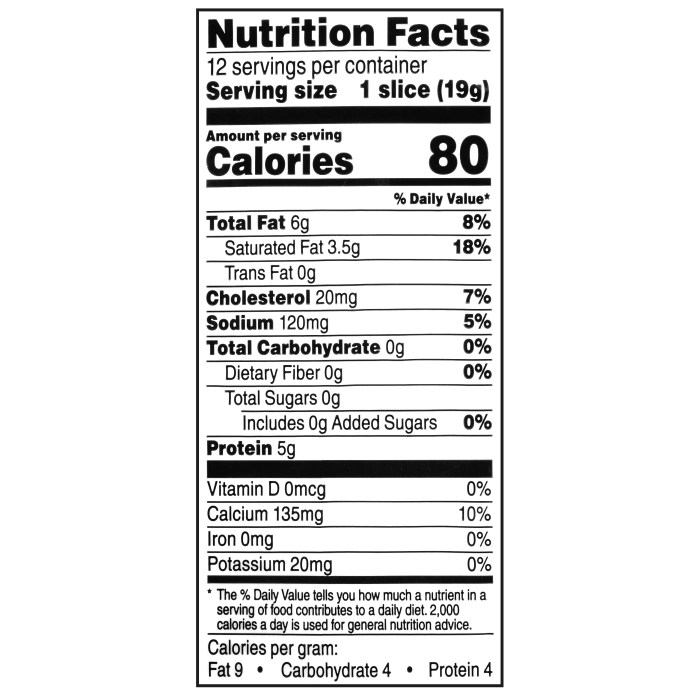Health Benefits and Potential Drawbacks

1 oz cheddar cheese nutrition facts – Cheddar cheese, a culinary staple enjoyed worldwide, offers a complex nutritional profile. Understanding both its potential benefits and drawbacks is crucial for incorporating it responsibly into a balanced diet. Moderate consumption can contribute positively to health, while excessive intake may present challenges.
Cheddar cheese is a good source of several essential nutrients. Its nutritional value stems from its composition of protein, calcium, and various vitamins and minerals. However, it’s also relatively high in saturated fat and sodium, which necessitates mindful consumption.
Nutritional Benefits of Moderate Cheddar Cheese Consumption, 1 oz cheddar cheese nutrition facts
Moderate consumption of cheddar cheese can offer several health advantages. The calcium content is particularly noteworthy, contributing significantly to bone health and reducing the risk of osteoporosis, especially important for women after menopause and older adults. Furthermore, the protein in cheddar cheese aids in muscle building and repair, crucial for maintaining overall physical function. The presence of vitamins like vitamin A and vitamin K2 also contributes to overall well-being, supporting immune function and bone health respectively.
Additionally, cheddar cheese provides smaller amounts of other essential vitamins and minerals like riboflavin and zinc.
Potential Drawbacks of Excessive Cheddar Cheese Consumption
Excessive cheddar cheese consumption can lead to several health concerns. The high saturated fat content can contribute to elevated cholesterol levels, increasing the risk of heart disease. Similarly, the high sodium content can raise blood pressure, a major risk factor for cardiovascular diseases and stroke. Individuals with pre-existing conditions such as high cholesterol or hypertension should exercise particular caution and limit their cheddar cheese intake.
Furthermore, the high calorie density of cheddar cheese can contribute to weight gain if consumed in excess, especially when combined with a generally unhealthy diet.
Cheddar Cheese in a Balanced Diet
Incorporating cheddar cheese into a balanced diet requires moderation and mindful choices. It can be a valuable source of nutrients, but it shouldn’t be the cornerstone of a healthy eating plan. Consider using it as a complement to other foods rather than a primary source of protein or calcium. Choosing lower-fat varieties can help mitigate some of the drawbacks associated with high saturated fat intake.
Furthermore, being mindful of portion sizes is crucial to manage sodium and calorie intake. A balanced diet rich in fruits, vegetables, whole grains, and lean proteins, with cheddar cheese as a small component, is the most effective approach to maximizing its benefits while minimizing potential risks.
Summary of Health Benefits and Drawbacks
Let’s summarize the key points regarding the health impacts of cheddar cheese consumption:
- Potential Health Benefits:
- Good source of calcium, vital for bone health and reducing osteoporosis risk.
- Provides protein, essential for muscle building and repair.
- Contains vitamins A and K2, supporting immune function and bone health.
- Offers small amounts of other essential vitamins and minerals, like riboflavin and zinc.
- Potential Drawbacks:
- High in saturated fat, potentially raising cholesterol levels and increasing heart disease risk.
- High in sodium, which can elevate blood pressure and contribute to cardiovascular problems.
- High calorie density, potentially leading to weight gain if consumed excessively.
Cheddar Cheese Varieties and Nutritional Differences
Cheddar cheese, a beloved staple in many cuisines, comes in a wide range of varieties, each boasting a unique flavor profile and, consequently, slightly different nutritional content. The variations primarily stem from the aging process and the milk used in production. Understanding these differences can help you make informed choices based on your dietary needs and preferences.
The aging process significantly impacts the texture, flavor, and nutritional composition of cheddar cheese. As cheddar ages, it undergoes complex chemical changes that affect its moisture content, fat composition, and even the concentration of certain vitamins and minerals. This leads to noticeable variations in the final product, from the mild, creamy texture of young cheddar to the firm, crumbly consistency of extra-sharp varieties.
Types of Cheddar Cheese and Their Nutritional Profiles
The primary distinctions in cheddar cheese varieties are based on their aging period, resulting in differences in flavor intensity and texture. Mild cheddar, for instance, is aged for a shorter period, resulting in a milder, sweeter taste and a softer texture. As the aging process extends, the flavor intensifies, moving from medium to sharp to extra-sharp, with corresponding changes in texture and nutritional composition.
Generally, longer aging leads to a reduction in moisture content and an increase in the concentration of certain components.
Understanding the nutritional breakdown of 1 oz cheddar cheese, including its fat and protein content, is crucial for mindful eating. Want to compare it to another dairy product? Check out the detailed nutrition information cream cheese provides, which offers a different profile of fats and calories. Returning to our cheddar, remember that portion control is key to maximizing its nutritional benefits within a balanced diet.
Fat Content and Calorie Density Comparison
The following table illustrates the approximate variations in fat content and calorie density across different cheddar cheese varieties. It’s important to note that these values can vary slightly depending on the manufacturer and specific production methods. Always check the nutrition label on the specific product for the most accurate information.
| Cheddar Type | Fat Content (g/oz) | Calories (per oz) | Moisture Content (Approximate %) |
|---|---|---|---|
| Mild | 8-9 | 110-120 | 38-42 |
| Medium | 9-10 | 120-130 | 35-38 |
| Sharp | 10-11 | 130-140 | 32-35 |
| Extra-Sharp | 11-12 | 140-150 | 28-32 |
Impact of Aging on Nutritional Content
The aging process of cheddar cheese leads to several changes in its nutritional profile. As the cheese ages, the moisture content decreases, resulting in a higher concentration of fat, protein, and other nutrients per ounce. However, the total amount of certain vitamins and minerals might decrease slightly due to chemical reactions and degradation over time. For example, some water-soluble vitamins might be lost during the aging process.
The concentration of certain amino acids and peptides might also change, influencing the flavor and potentially impacting the bioavailability of some nutrients. While the overall nutritional value might not change dramatically, the concentration of certain components does shift, making extra-sharp cheddar more calorie-dense and fat-rich than its milder counterparts.
Visual Representation of Nutritional Information

Understanding the nutritional content of cheddar cheese can be easier with visual aids. A well-designed infographic or chart can quickly convey complex data, making it accessible to everyone. Below, we’ll explore two visual approaches to represent the nutritional information of a 1-ounce serving of cheddar cheese.
Macronutrient Composition Infographic
This infographic would visually represent the proportions of fat, protein, and carbohydrates in a 1-ounce serving of cheddar cheese. Imagine a circular pie chart, where each slice represents a macronutrient. The largest slice would represent fat, given its high fat content. The color scheme would be intuitive: a rich, creamy yellow for fat, a light beige or tan for carbohydrates, and a deep orange for protein.
Each slice would be clearly labeled with the percentage of each macronutrient and its corresponding gram amount. For instance, if fat comprises 70% of the calories, the yellow slice would be significantly larger than the others, and clearly labeled “Fat: 8g (70%)”. The chart would be placed on a background of a subtly textured, pale yellow to evoke the color of cheddar cheese, enhancing the visual appeal and thematic consistency.
A small legend at the bottom would reiterate the macronutrient abbreviations (Fat, Protein, Carbohydrate) and their associated colors for clarity.
Vitamin and Mineral Content Bar Chart
A horizontal bar chart would effectively showcase the vitamin and mineral content of a 1-ounce serving. Each bar would represent a specific vitamin or mineral (e.g., Calcium, Vitamin A, Riboflavin). The length of the bar would correspond to the amount of each nutrient, expressed as a percentage of the recommended daily intake (%RDI) or in milligrams (mg). The color scheme would use distinct, easily distinguishable colors for each nutrient.
For example, calcium could be represented by a light blue, Vitamin A by a vibrant orange, and so on. A key would be included to identify each color and the corresponding nutrient. The chart would be neatly organized with clear labels for each bar, showing both the nutrient name and its quantity (%RDI or mg). To further enhance readability, the bars could be grouped into categories (e.g., major minerals, fat-soluble vitamins, water-soluble vitamins) for easier comprehension.
The background color could be a light, neutral shade to avoid distraction from the data itself. The overall design would be clean, uncluttered, and easy to read, prioritizing the clear and concise presentation of the nutritional data.
Key Questions Answered: 1 Oz Cheddar Cheese Nutrition Facts
What are the potential long-term health effects of consuming excessive cheddar cheese?
Excessive cheddar cheese consumption can contribute to high cholesterol, increased risk of heart disease due to saturated fat, and hypertension due to high sodium content. Long-term effects may include weight gain and related health complications.
How does the nutritional content of cheddar cheese compare to plant-based cheese alternatives?
Plant-based cheeses generally contain less saturated fat and cholesterol than cheddar cheese, but may vary in protein and calcium content. Nutritional profiles differ significantly across brands and types.
Is cheddar cheese suitable for individuals with lactose intolerance?
Cheddar cheese contains lactose, although aged cheddar often has lower lactose content than younger cheeses. Individuals with lactose intolerance may experience varying levels of discomfort; some may tolerate small amounts while others cannot.
Can cheddar cheese be part of a healthy diet?
Yes, in moderation. Cheddar cheese provides calcium and protein but should be consumed as part of a balanced diet, mindful of saturated fat and sodium intake.



